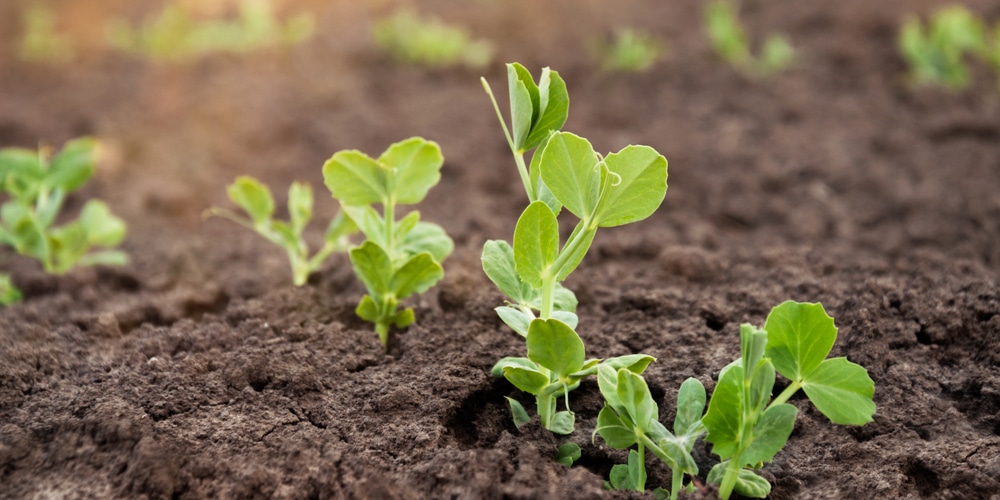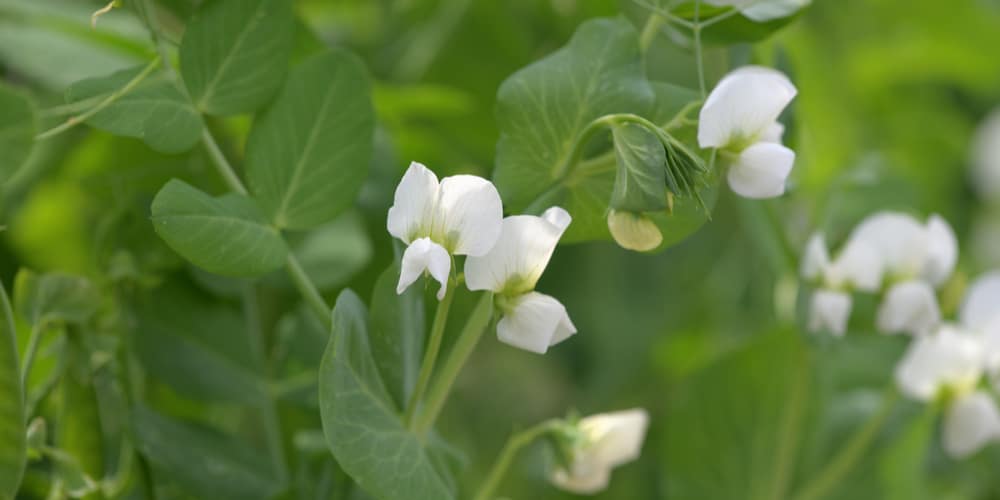Peas are a quintessential spring crop. They are one of the easiest and most tasty and pleasurable starchy vegetables you can grow in spring. And although there are different types that you may want to consider before planting them, the pea plant growth stages remain the same.
What Are The Growing Stages Of Pea Plants?

The four pea plant growth stages are:
- Germination
- Vegetative state
- Reproductive stage
- Senescence (mature stage)
Pea Growth Factors
Peas can tolerate cold, even a light frost. Plus, they are ok having wet feet. That is, when the soil is a little overly moist. As a matter of fact, growing peas in the warmer areas is harder unless the grower keeps the temperature low, especially in the summer.
While temperature can be an issue, these plants do not need much space. So, you can plant them anywhere from 1 to 3 inches apart, and they will develop relatively shallow roots, focusing on growing upwards. This little detail is critical as pea plants are quite forgiving and do not seem to mind competing with one another. So, two or more plants can come out of the same hole without growth delays.
Pea plants do not like very heavy clay soil. On top of that, they need frequent watering throughout their life cycle, especially early on. Otherwise, they will become yellowish and eventually dry out.
Germination And Emergence
At temperatures ranging from 65 to 70 F, pea seeds usually sprout within 5 to 14 days. But they could take longer in cold soil. Also, fresh seeds have a higher germination percentage (around 90%) than dry pea seeds at the recommended seeding depth of 1.5 inches.
Pea seeds germinate well in potting trays and directly in the ground. But transplanting them may damage the delicate roots, causing a lot of Nitrogen to escape from the soil as well.
As long as the temperature stays cool, a pea sprout only needs six to seven hours of sun per day. Pre-sprouted seeds get a jumpstart on growth, which will shorten the period to reach the other pea plant growth stages.
As mentioned, seeds and sprouts need enough moisture to grow. They prefer medium mixture soils that provide good drainage. When the roots spread out, they mainly go sideways. They tend to go down only in potting trays. Besides their fragility, the pea roots dig composted organic matter and are heavy feeders.
If the grower does not nip the central growing tip, the seedlings will look for support while growing taller than 2 inches.
The Vegetative State
The vegetative state is the longest phase of the four pea plant growth stages. In nature, the pea plants would grow under the shade of other plants. But most of them would die because of aphids and other pests, which find pea plants appetizing.
In early June, the seeds planted in late February are fully grown and virtually ready to produce flowers. The plants have tendrils that help them attach to whatever support or plant they find to keep growing upward.
The plant releases nitrogen into the soil in this stage. But it also consumes large quantities of water. Underwatering and excessive heat can stress the plant to the point of termination. The plant will then stop growing, not produce flowers and pods. On the other hand, overwatering can rot the roots. Plus, the moist environment can invite other problems like fungal diseases.
Even at this stage, the plants do not mind growing close together to one another. But the foliage will start to wilt if the plant needs water. Good aeration is also a critical factor. Mainly because humidity and moisture buildup lead to leaf diseases like powdery mildew.
Wind damage often causes the pea plants to bend over. This is why finding support is critical for the plant in the previous stage. The whole vegetative stage takes 30 to 70 days to reach the reproductive phase.
Flowering And Reproduction
The pea plant produces beautiful, ornamental flowers with a pleasant smell. They are bilaterally symmetrical flowers (zygomorphic) with a superior ovary and self-pollinating. In detail, each flower has five sepals and five petals.
As soon as the pea plant bears flowers, the plant water consumption drops drastically. Occasional waterings are welcome. But the plant stops demanding large amounts of water. Excessive moisture then becomes a haven for spores, which only shorten the plant’s life cycle.
Thanks to bees and other insects, the flowers turn into pods, producing new seeds.
When a pea pod is ready for harvest, the pod plumps up and fills out. After that time, the pod becomes tough and bitter to the taste. Continuous harvesting can induce the plant to produce more pods for a couple of months.
The healthy, flourishing, and producing plants continue to create new flowers and pods until they reach the peak of pea pod production. After that, the plants will go into senescence.
The Mature Stage
The pea plant is an annual plant that concludes its life cycle within 140 days. Winter pea varieties can reach senescence in 240 days maximum.
Peas naturally die back towards their end of life. In brief, they wilt with leaf diseases at the end of the harvesting season. In the meantime, the crop matures fully, dries out, and the pods become ready to fall and decay, leaving the seeds space to germinate.
Age-related developmental senescence looks like brownish leaves, darkened stems, and white, dry peas.
Pea plants are nitrogen fixers. But they do not actually fix chemical nitrogen in the soil. When the plant hits the last of the pea plant growth stages, the roots release the bacteria that create nitrogen back into the ground.
Pea Plant Growth Stages, Development, and Life Cycle: Conclusion
All throughout their life cycle, pea plants create the ideal habitat for the bacteria responsible for nitrogen production inside their root nodules. When the pea plant dies, the nitrogen-fixing bacteria inside the root nodules slowly release ammonium, which feeds neighboring plants and microorganisms.
The decaying roots also feed helpful fungi that make the soil even more hospitable to useful bacteria. Finally, root decomposition frees Iron, Copper, Zinc, and Phosphorus back into the ground.

